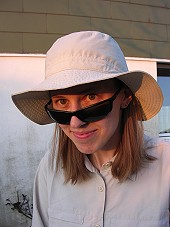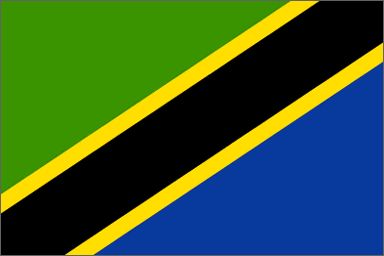
MARTINA'S WORLD TRIP
TANZANIA: June 1 - June 22, 2004


(Übersetzungshilfe)
 |
MARTINA'S WORLD TRIP TANZANIA: June 1 - June 22, 2004 |
|||||||
 |
||||||||
 |
Your Dictionary
(Übersetzungshilfe) |
|||||||
| Wednesday, June 16th, 2004 - Spice Tour | ||||||||
| Wednesday, June 16th, 2004 Spice Tour After my first night at the congregation’s guesthouse and a breakfast they provided, Pastor Ntele introduced me to Saraphia, a girl in her early 20s who is an active member of the congregation. Saraphia was supposed to accompany me on today’s Spice Tour, so I would have somebody to translate when necessary and didn’t have to be on my own all the time. We were picked up at 9 am and spent the next three hours sightseeing and “spice touring” on a plantation just outside Stone Town. Before arriving at the plantation, we first visited the ruins of Maruhubi Palace. The estate was bought by Seyyid Barghash (Sultan of Zanzibar 1870 – 1888) from an Arab of the Maruhubi tribe (hence the name) and is thickly planted with mango trees imported from India. The Sultan built the palace for the use of his harem in 1880-1882. The palace accidentally burnt down in 1899 but some of the pillars that supported the large balconies and part of the walls still remain. Adjoining the palace are the domed Persians Baths with six individual changing rooms. Our guide told us that the Sultan would invite six concubines, one for each day, to this palace and let them stay for one week. Afterwards they would be replaced by new virgin flesh. (Something interesting I found about the wealth and excess of Zanzibar’s Sultans: Until 1911, the Sultan of the day maintained a harem of around 100 concubines, all with attendant eunuchs. He slept with 5 concubines a night, in strict rotation and many concubines had children, who were supported by the Sultan’s riches.) We also went to see the Persian Baths of Kidichi, or better what remains of it. Although the site is a legally protected historical monument, it is unfortunately quite run down. The Bath was built by Seyyid Said, the first Sultan of Zanzibar who ruled 1804 – 1856. Legend has it that he built the Bath for his wife, Princess Sherezade, granddaughter of Mohammed Shah of Persia. Historians claim, however, that he married her in 1847, whereas the inscription of 1832, which is decorating the interior of the baths, would prove that the construction must have taken place before their marriage... If you ever go to Zanzibar, I can only recommend for you to go on a Spice Tour where you can actually see, smell, touch and taste the wide variety of plants, fruits and spices for which Zanzibar is famous. Here is a list of some of the stuff I got to try: Green, red, black and white pepper (did you know that they all come from the same plant but that their colours are the result of different treatment?), banana, orange, giant lemon, avocado, mango, papaya, jackfruit, starfruit, litchi, coconut, henna, cinnamon, vanilla, curry, ginger, nutmeg, clove, ylang ylang, lemon grass and quite a few more. What was most embarrassing for me was to realise that I am an absolute illiterate when it comes to identify a certain spice by its natural looks, smell or consistency. Unless I was told that I was holding cinnamon bark, vanilla stems or a piece of ginger root in my hand, I basically only knew those spices dried or as a grounded powder amongst my mother’s cooking ingredients. I had never seen a nutmeg (Muskatnuss) in its shiny dark wrapping nor green cloves (Nelken) growing on bush branches. By the way, Zanzibar used to be the world’s largest producer of cloves, and although cloves are still a major export along with coconut products and spices, tourism has developed into the primary foreign exchange earner. (Still, numbers are relatively small with less than 100,000 tourists per year.) After having smelled several spices, my nose was kind of numb, so in the end I couldn’t even recognise the easiest plants like curry or cinnamon anymore, in spite of their very distinct odour. I didn’t even want to know what our guide must have thought about my civilised poor nose at this stage but he was very patient and explained all the spices and their particular use in cuisine, medicine and cosmetics to us. At some point he was joined by a young boy who climbed up a palmtree and cut off some coconuts, so Saraphia and I got to drink fresh coconut milk. He also made us some necklaces, leaf cones and even a handbag for me, only by folding and braiding leaves. It was amazing. At the end of the tour you can buy spices and tea which I did. We returned to Mwanakwerekwe around noon and had an hour of rest before both Saraphia and I got picked up again for our next appointment of the day: We were invited for lunch to a Missionary Pastor in Stone Town. It turned out that Arngeir (Norwegian) and his wife Dorthe (Danish) were a young European couple from Scandinavia, who lived and worked as missionaries on Zanzibar for about two years. They had a little baby-boy called Noah and lived in the heart of Stone Town with a great view over the roofs of the city. It was a totally new concept for me to imagine Europeans of my age working as missionaries in Africa and I had to admit to myself that I didn’t even have a clue of what exactly a missionary would do nowadays. In my head I still saw pictures out of history books where grey-haired men in traditional religious gowns land on foreign shores and try to evangelise native inhabitants by showing them their crosses and by telling intimidating stories about heaven and hell. Nothing could be more different than what I experienced here: a modern young (white) couple with a baby, whose (black) housemaid sat at the same table with us when we had lunch and was totally treated as part of the family. Yes, we prayed before eating but by singing a cheerful song that was appropriate even for Noah. I loved it. After lunch I actually took the occasion to ask Arngeir and Dorthe some questions about modern missionary work and their motivation to choose this “career”. We had some very interesting discussions and overall, I very much enjoyed my visit at their place (not only because lunch was entirely vegetarian!). Saraphia and I left them around 4:30 pm and still spent some time in Stone Town before taking a taxi home. At 7 pm I was invited to have dinner with the family of Dr. Shunula, a member of the church elders and a personal friend of my parents. He picked me up at the congregation and I had to sit behind him on a Honda moped to drive back to his place. Quite an experience to ride through the night on a noisy moped and bumpy sand roads, I can tell you! Dr. Shunula had quite a big house, which was appropriate for a family of his size, and again I was very warmly welcomed by everybody. Some of the children still remembered my sister who had been here with my parents some years ago and they were excited to meet me as the last (missing) member of my family. They even showed me photos of my parents visiting in 1996 and altogether, we had great fun this evening. |
||||||||